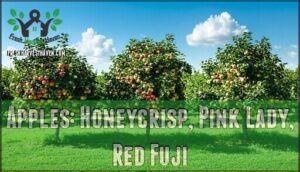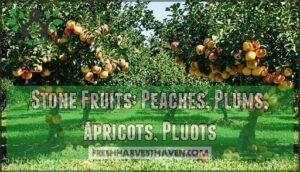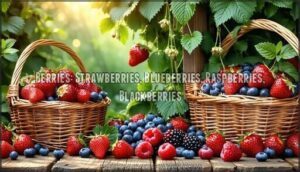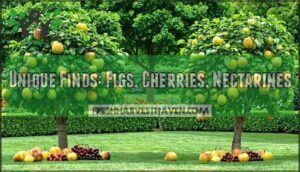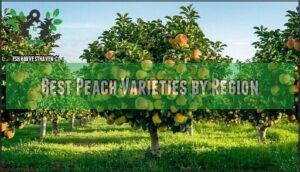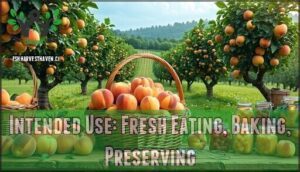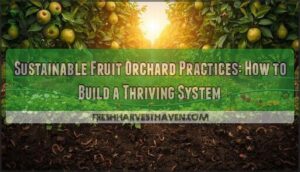This site is supported by our readers. We may earn a commission, at no cost to you, if you purchase through links.
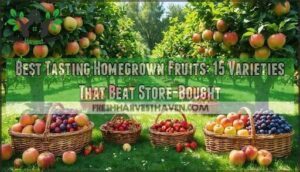
Your Honeycrisp apple reaches 15% sugar content when tree-ripened, while store-bought versions are picked green for shipping.
Homegrown strawberries taste like candy because their natural sugars fully develop on the plant, and you’re eating them within hours of picking instead of weeks later.
Stone fruits like peaches and plums develop their buttery texture and complex flavors only when allowed to ripen naturally.
Plus, your homegrown fruits retain 30-50% more vitamin C than their traveled counterparts.
The secret lies in variety selection—choosing cultivars bred for taste rather than shelf life.
Table Of Contents
- Key Takeaways
- What Makes Fruit Taste Exceptional
- Top Homegrown Fruits for Outstanding Flavor
- How to Select The Best Fruit Varieties
- Choosing The Perfect Peach for Your Garden
- Tips for Growing Flavorful Fruit at Home
- Frequently Asked Questions (FAQs)
- Do homegrown fruits taste better?
- What is the best tasting fruit on Earth?
- What is the best fruit to grow in your backyard?
- Which fruit varieties store longest after harvest?
- How does watering frequency affect fruit sweetness?
- Whats the minimum space needed for dwarf trees?
- Do organic fertilizers improve homegrown fruit taste?
- Conclusion
Key Takeaways
- You’ll taste the difference immediately when you harvest fruit at peak ripeness instead of picking green for shipping – homegrown strawberries develop candy-like sweetness that makes store-bought taste like cardboard
- Your variety selection matters more than anything else – choose cultivars bred for flavor rather than shelf life, like Honeycrisp apples that reach 15% sugar content when tree-ripened
- You’re getting 30-50% more vitamin C and nutrients because there’s zero transport time between your plant and your plate, preserving both flavor and nutritional value
- You can grow exceptional varieties that stores don’t carry – like Flavor King pluots, Blenheim apricots, and Panache figs that deliver complex flavors impossible to find commercially
What Makes Fruit Taste Exceptional
You’ve probably noticed that homegrown strawberries taste like candy compared to their cardboard cousins from the grocery store.
Homegrown fruit makes store-bought taste like expensive disappointment wrapped in pretty packaging
The secret lies in three key factors: variety selection, ripeness at harvest, and the journey from plant to plate.
homegrown-fruit-intro
text/markdown
Introduction: What Makes Fruit Taste Exceptional
You’ve probably noticed that homegrown strawberries taste like candy compared to their cardboard cousins from the grocery store.
The secret lies in three key factors: variety selection, ripeness at harvest, and the journey from plant to plate.
Factors Influencing Fruit Flavor
When you’re chasing that perfect bite, fruit flavor depends on a delicate dance between sugar content and acid levels.
Harvest timing is everything—pick too early and you’ll miss peak sweetness, wait too long and those flavor profiles turn mushy.
Temperature, sunlight exposure, and soil nutrients all influence flavor intensity, creating the complex taste enhancement that makes homegrown fruit so addictive.
Homegrown Vs. Store-Bought Taste
When you grow fruit at home, you’re discovering flavor profiles that make store-bought varieties taste like pale imitations.
Homegrown fruits consistently win taste tests because they’re harvested at peak ripeness rather than picked green for shipping.
Here’s what makes the difference:
- Harvest timing – You pick when perfectly ripe
- Zero transport time – No flavor loss during shipping
- Variety selection – Choose cultivars bred for taste, not shelf life
- Freshness preservation – Eat within hours of picking
- Flavor intensity – Natural sugars develop fully on the plant
This homegrown vs storebought comparison isn’t even close.
Impact of Freshness and Ripeness
Timing your harvest transforms ordinary fruit into something magical. When you pick fruit at the perfect harvest time, you’ll taste the difference immediately.
The ripening process concentrates sugars and develops complex flavors that disappear once fruit sits too long. Freshness matters most with delicate varieties like ripe peaches, where texture changes dramatically within hours.
You’ll discover that juicy fruits picked at peak ripeness deliver flavorful fruits that make store-bought seem bland by comparison. Understanding ripeness indicators is essential for achieving the perfect harvest.
This process highlights the importance of ripeness and how it affects the quality of the fruit, making it crucial for a successful harvest.
Top Homegrown Fruits for Outstanding Flavor
When you grow fruit at home, you discover flavors that grocery stores simply can’t deliver.
These varieties will transform your backyard into a gourmet fruit paradise where every bite rivals the world’s finest orchards.
Apples: Honeycrisp, Pink Lady, Red Fuji
Why do homegrown apples win taste tests? These Crisp Varieties deliver unmatched Flavor Profiles that make store-bought apples seem bland.
- Honeycrisp: 13-15% sugar content creates candy-like sweetness with explosive juice
- Pink Lady: Complex floral notes develop from late Apple Harvest timing
- Red Fuji: Up to 16% sugar content makes them irresistibly sweet
Your homegrown fruits retain 30-50% more vitamin C, while Winter Storage maintains superior Fruit Texture for months. Homegrown apples also offer better apple product options for consumers.
Stone Fruits: Peaches, Plums, Apricots, Pluots
Stone fruits deliver flavor experiences you’ll never find at the grocery store.
Your homegrown peaches ripen to buttery perfection, while store varieties often taste like disappointment wrapped in fuzzy skin.
Peach varieties like Eva’s Pride and Donut offer unique textures and sweetness levels.
Plum varieties such as Catalina provide firm, sweet flesh without tartness.
Blenheim apricots burst with aromatic sweetness, and Flavor King pluots combine spicy-sweet complexity.
Stone fruit pollination requirements vary, but the payoff in taste makes every effort worthwhile.
Berries: Strawberries, Blueberries, Raspberries, Blackberries
Nothing beats the candy-like sweetness of strawberries ripened on the vine versus their bland store counterparts.
Homegrown strawberries burst with candy-like sweetness that makes store-bought varieties taste like cardboard disappointments
Homegrown berries deliver superior berry nutrition and flavor that’ll spoil you forever.
Strawberry care requires well-draining soil and consistent watering, while raspberry pests need monitoring during blueberry harvest season.
These versatile gems shine in blackberry recipes too, offering a unique taste experience with their superior berry nutrition.
Unique Finds: Figs, Cherries, Nectarines
Beyond berries, your garden can showcase some truly special homegrown fruits that’ll make neighbors jealous.
Figs like Panache deliver exceptionally fine flavor with green-yellow striped skin and dark red pulp. Craig’s Crimson cherries offer spicy, firm sweetness that ripens early May. Arctic Glo nectarines provide balanced sugar-acid content for that perfect tangy-sweet bite.
These stone fruit varieties ripen better on the tree than anything you’ll find at stores.
For superior growth, understanding soil requirements is vital for exotic and unusual fruits.
How to Select The Best Fruit Varieties
You can’t just pick any fruit tree and expect backyard magic—your climate zone, available space, and sun exposure determine which varieties will actually thrive and produce those incredible flavors you’re after.
Smart variety selection means matching specific cultivars to your unique growing conditions, from chill hour requirements to disease resistance, ensuring your homegrown harvest delivers on its promise.
Matching Varieties to Your Climate
Your regional climate determines which fruit varieties will thrive and deliver exceptional flavor.
Check your USDA zones first—apples need specific chill hours ranging from 200-1,000, while southern gardeners should choose low-chill varieties like ‘Anna’ apple.
Climate zones affect sugar content, disease resistance, and whether your homegrown fruits actually fruit!
Understanding the proper climate zone fruits is essential for a successful harvest.
Considering Your Space and Sunlight
Before you plant, assess your available space and sunlight requirements for ideal garden layout.
Dwarf fruit trees work perfectly for container gardening in tight spaces, while full-size varieties need proper yard optimization.
Most fruits demand six hours of direct sunlight daily, though some berries tolerate partial shade.
Vertical gardening maximizes space planting potential when horizontal room runs short.
Understanding the importance of climate considerations is vital for selecting the right fruit varieties that will thrive in your specific environment with the right sunlight requirements and proper yard optimization.
Chill Hours and Disease Resistance
Your fruit trees need enough chill hours to break dormancy and produce quality fruit.
Peaches require 200-1000 chill hours depending on variety, while apples need similar ranges.
Choose disease-resistant cultivars like fire blight-resistant pears or bacterial spot-tolerant peaches.
Cold hardiness zones matter too—Belle of Georgia thrives in zones 5-8, while Arctic Supreme handles colder temperatures.
Match your selections to local climate conditions and disease pressure.
Choosing The Perfect Peach for Your Garden
Peaches aren’t just fuzzy fruits—they’re your ticket to summer sweetness that makes store-bought versions taste like cardboard.
You’ll want to choose between melting types for fresh eating, freestones for baking, or clingstones for preserves, depending on how you plan to enjoy your homegrown harvest.
Melting, Clingstone, and Freestone Types
Understanding peach texture helps you pick the right variety for your needs.
Melting peaches develop that buttery, soft texture as they ripen, perfect for fresh eating but prone to becoming mealy.
Clingstone peaches stay firmer with sweet, juicy flesh that clings to the pit—great for snacking, while freestone peaches separate easily from the stone, making them ideal for slicing and cooking projects.
Best Peach Varieties by Region
Your region’s climate determines which peach varieties will thrive in your backyard.
Northern growers should choose ‘Redhaven‘ for exceptional midseason flavor, while ‘Reliance‘ handles harsh winters down to −25°F.
Southeastern gardeners can’t go wrong with disease-resistant ‘Elberta‘ or aromatic ‘Georgia Belle’.
Western states favor heat-tolerant ‘Desert Gold’ and ‘O’Henry’ for extended harvest timing and superior peach flavors.
Intended Use: Fresh Eating, Baking, Preserving
Your intended use shapes everything about variety selection.
Clingstone peaches deliver the juiciest peaches for fresh eating, with their soft, sweet flesh perfect for immediate consumption.
For baking tips, choose firmer freestone varieties that hold their shape in pies and cobblers.
Preserving methods work best with balanced sugar-acid ratios – harvest timing matters more than variety.
Proper fruit storage extends your homegrown bounty’s shelf life substantially, and understanding this can help you make the most of your homegrown bounty.
Tips for Growing Flavorful Fruit at Home
You’ve already mastered choosing the right varieties for your garden—now let’s make sure they taste as incredible as they should.
The difference between mediocre and mind-blowing fruit often comes down to how you grow, care for, and harvest your trees.
Soil Preparation and Fertility
Behind every sweet, juicy homegrown fruit lies healthy soil that’s properly prepared and fertilized.
Start with soil testing to check pH levels and nutrient availability – most fruits thrive in well-draining soil with pH between 6.0-7.0.
Add compost annually to boost organic matter and improve nutrient cycling. Choose slow-release fertilizer types over quick fixes for sustained soil health and enhanced drainage.
Accurate soil analysis requires using a soil test kit to determine the ideal fertilizer application.
Pruning and Tree Care
Proper tree pruning sets the stage for sweet, abundant harvests.
Remove dead, diseased, or crossing branches during dormant season to improve airflow and sunlight penetration.
Thin heavy fruit loads early summer—your peach tree will thank you with larger, more flavorful fruit.
Train branches outward for better light exposure and easier picking, which ultimately leads to sweet harvests.
Harvesting at Peak Ripeness
Perfect timing makes all the difference between bland store-bought disappointment and backyard bliss.
You’ll taste the magic when your homegrown fruits reach their sweet spot.
Master these ripening techniques for peak flavor:
- Fruit Monitoring: Check daily for color changes and gentle softness
- Sugar Content: Test with gentle squeeze – ripe peaches yield slightly to pressure
- Harvest Timing: Pick when fruits release easily from branches with light twist
Protecting Fruit From Pests and Disease
Through strategic pest control and disease prevention, you’ll safeguard your fruit harvest while maintaining those exceptional flavors.
Monitor crops weekly using sticky traps to catch garden pests early. Apply organic sprays like neem oil when thresholds are reached, reducing powdery mildew by 50%.
Practice garden sanitation by removing fallen fruit and diseased leaves. Fine-mesh netting blocks birds effectively, while beneficial insects naturally control soft-bodied pests in most orchards.
Effective pest control methods are essential for a healthy and productive fruit tree, ensuring the best possible outcomes through strategic management.
Frequently Asked Questions (FAQs)
Do homegrown fruits taste better?
Picture biting into a store-bought strawberry versus one you’ve just plucked from your garden—it’s like comparing cardboard to candy.
Homegrown fruits ripen naturally on the plant, developing complex sugars and flavors that mass-produced varieties simply can’t match when picked green and shipped.
What is the best tasting fruit on Earth?
There’s no single "best" fruit – taste is personal!
Homegrown Honeycrisp apples, Bing cherries, or Flavor King pluots often top lists for their incredible sweetness and complexity you can’t find in stores.
What is the best fruit to grow in your backyard?
Growing your own fruit orchard transforms your backyard into nature’s candy store.
You’ll discover strawberries offer the sweetest rewards – they’re beginner-friendly, ripen perfectly on the plant, and deliver candy-like flavor that’ll make store-bought berries taste like cardboard by comparison.
Which fruit varieties store longest after harvest?
Apples like Red Fuji and Pink Lady excel at long-term storage, staying crisp for months. Pears, particularly Seckel varieties, also keep well when properly stored in cool, humid conditions.
How does watering frequency affect fruit sweetness?
Water-starved fruit trees produce flavor bombs that’ll make your taste buds dance.
When you stress trees by reducing watering frequency, they concentrate sugars dramatically, creating intensely sweet fruit that surpasses well-watered counterparts every time, making them a true taste sensation.
Whats the minimum space needed for dwarf trees?
You’ll need just 6-8 feet between dwarf fruit trees, or they’ll thrive in containers as small as 15-20 gallons. They’re perfect space-savers for patios and small yards!
Do organic fertilizers improve homegrown fruit taste?
Organic fertilizers can enhance fruit flavor by improving soil health and nutrient balance. They release nutrients slowly, promoting better sugar development and more complex flavors compared to synthetic alternatives.
Conclusion
Like Demeter’s gift of the harvest to humanity, growing your own best tasting homegrown fruits transforms your garden into a personal orchard of unmatched flavor.
You’ll discover that patience pays dividends when you bite into sun-warmed strawberries or tree-ripened peaches that never saw a shipping container.
Your taste buds won’t lie—homegrown varieties consistently deliver superior sweetness, complex flavors, and nutritional value that store shelves simply can’t match.
Start planting today for tomorrow’s delicious rewards.
- https://www.marthastewart.com/fruits-and-vegetables-that-taste-better-than-store-bought-11734565
- https://www.youtube.com/watch?v=wpnD2pBwwnE
- https://pmc.ncbi.nlm.nih.gov/articles/PMC11202461/
- https://extension.psu.edu/fruit-quality-how-do-fruit-get-their-flavor/
- https://www.houzz.com/discussions/1476306/taste-difference-between-home-grown-and-supermarket-fruits

